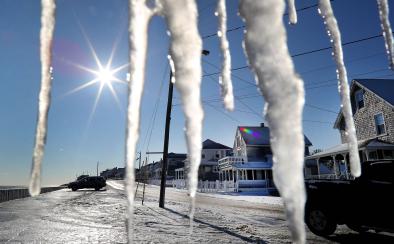What Is This "Bomb Cyclone" Threatening the U.S.?

What exactly is a “bomb cyclone”?
A bomb cyclone is a low-pressure system that intensifies very rapidly—you have to have a fall in pressure of at least 24 millibars in 24 hours to qualify as a “bomb cyclone,” or “bombogenesis,” event. When a storm has its pressure rapidly fall like that, it’s going to drive stronger winds, because winds try and blow to equalize differences in pressure. The atmosphere doesn’t like to have different pressures, so what will happen is the wind will flow from high pressure to low pressure to try and balance out the difference.
With this storm, which [has been] named Grayson, the biggest concern is very strong winds gusting as much as 60 miles per hour along much of the east coast. Those strong winds are probably going to cause a lot of power outages.
...
What kind of physical conditions create a bomb cyclone?
What has happened is the jet stream has gotten into a big kink. The jet stream is the band of high-altitude winds that goes from west to east over the mid-latitudes. But the jet stream can take a big dive and get a kink in it, so that it has a big loop that goes far to the south and then comes back far to the north. This means that you’re now bringing in very warm air on the east side of this kink flowing northwards—in this case, out over the Gulf Stream where you have got a lot of warm water, too. And just a few hundred miles west of there, now you have got cold Arctic air adjacent to this warm moisture that’s being pulled northward. Those two air masses of very contrasting temperatures are interacting, and the storm forms right along that high-energy boundary there.
What [the storm is] doing is, it’s drawing energy from the difference in temperatures—more technically, the difference in densities—between the two air masses. So the bigger the contrast between that cold Arctic air on the one side and the warm moist air from the ocean on the other side, the stronger your storm is going to be. In this case, that kink is very sharp, so there’s a very intense difference in air masses on either side of this jet stream boundary—and that’s driving the storm. In addition, you’re getting a little bit of energy coming from the ocean itself, like a hurricane does. Hurricanes derive their energy from warm ocean waters—they pull the energy right out of the ocean. This storm, Grayson, is also going to get some of its energy from the very warm Gulf Stream waters.
...
Could climate change be playing a role in this bomb cyclone?
We would expect it to be playing some role, since climate change is fundamentally affecting the atmosphere and changing the base state in which storms arise. So potentially you would have more moisture available to this storm, just because the oceans are hotter because of global warming—and that could potentially increase the impacts of a storm like this. There’s also some question about whether global warming might be affecting the jet stream, which is an important trigger for this storm. [Climate change] may be making the jet stream have more meanders, more of these large loops—these kinks—that can drive these sorts of storms. It’s an active area of research, and there hasn’t been unanimous scientific agreement about how climate change is affecting these storms.
Related Content



